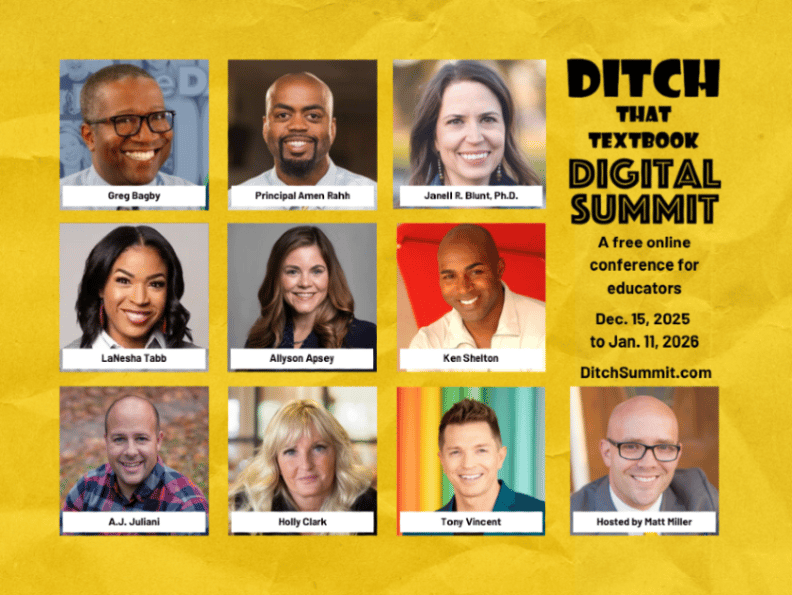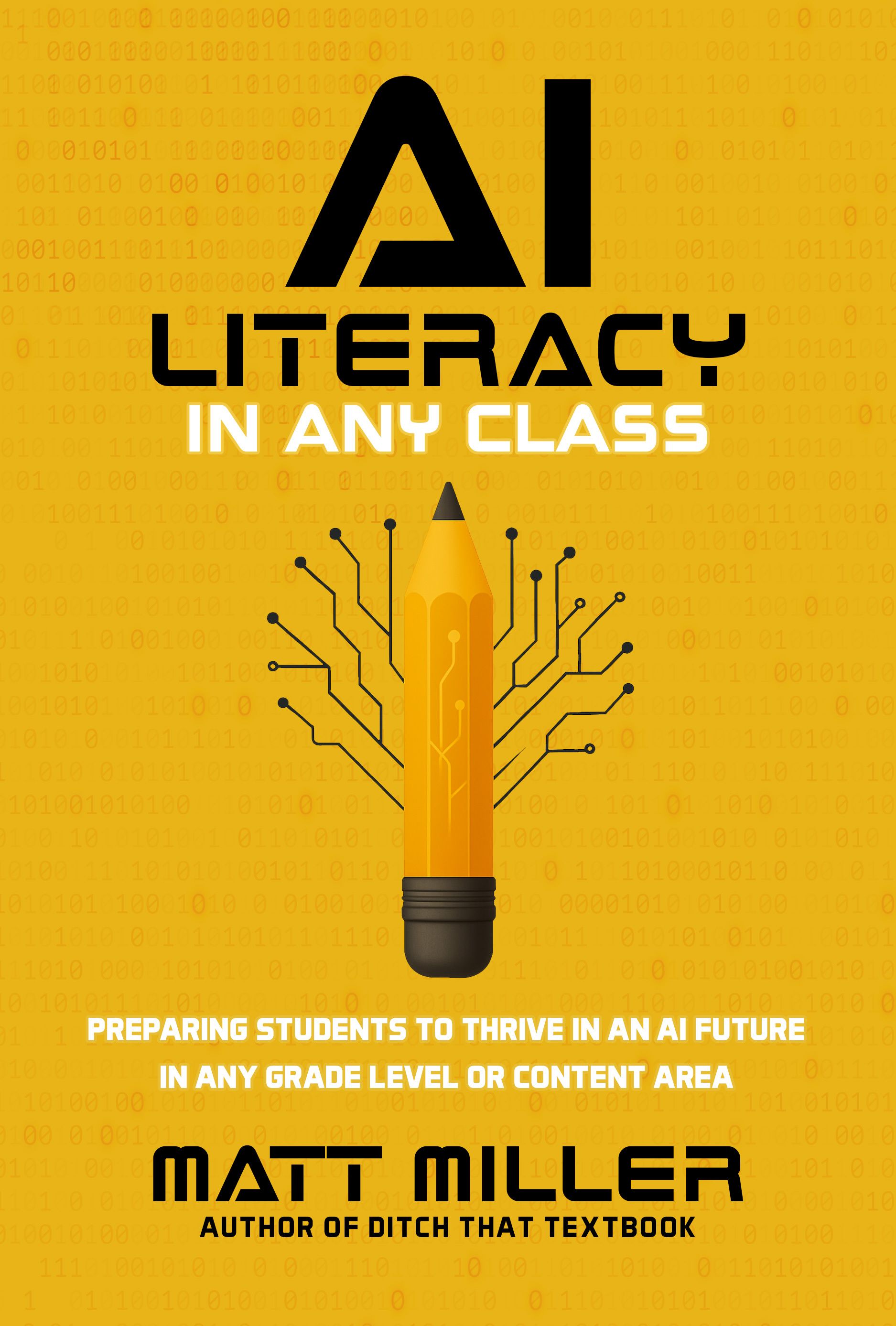- AI for Admins
- Posts
- 🤖 Preview: All 12 chapters of my new AI literacy book
🤖 Preview: All 12 chapters of my new AI literacy book
Check out the table of contents and summaries!

Writing a book is TOUGH.
Right now, I’m actively writing my seventh (!) book for educators, and each time, I fall into this toxic cycle …
I remember how proud I am of writing books and the impact they can make.
I come up with a new idea for a book and think of how much fun it’ll be to write.
I start writing.
I suffer … and agonize … and get tons of imposter syndrome. (Who am I to write this book?!?)
I painfully finish the manuscript — and vow to better remember how hard it is next time. (Even though I never do.)
There’s all of this talk right now about AI literacy. All of the gurus and politicians and influencers want to talk about the hype: preparing students for the future, how unprepared students (and teachers) are, what students (and teachers) must know to face this constantly-changing AI landscape.
Blah, blah, blah.
(Sorry … I don’t totally mean that. But I’m kind of sick of all of the hyperbole and high-level talk that doesn’t help anyone actually do anything to address the problem.)
Most of the organizations and politicians and influencers want to make things. Frameworks. Curricula. Acronyms.
I just keep thinking: Who is going to use this? How does this actually fit in a real school — in a real classroom?
It was time to do something. So I started writing.
Below, you’ll find summaries of all TWELVE chapters of my upcoming book, AI Literacy for Any Class. Publication goal: December 2025. (Stay tuned here for updates!)
In this week’s newsletter:
📺 Ditch Summit, a free virtual conference for educators
📚 New AI resources this week
📢 Your voice: Pedagogical bias in AI tools
🗳 Poll: Most important AI literacy concepts?
👀 Preview all 12 chapters of my new book
📺 Ditch Summit, a free virtual conference for educators

Register for the Ditch Summit at DitchSummit.com
📣 Announcing: The Ditch Summit speaker lineup!
It's our 10th year for this free online conference for teachers.
Dates: Dec. 15, 2025, to Jan. 11, 2026.
FREE PD certificates, too!
More details coming soon …
📚 New AI resources this week
1️⃣ Students express hope — and fear — over classroom AI use (via K-12 Dive) — Students said in a Project Tomorrow survey that they’re optimistic about the potential benefits of AI in their learning, but more school guidance is needed.
2️⃣ Will AI Save Education? Don't Count on It. (via Governing) — MIT professor Justin Reich writes that edtech has a history of failure. It will take years — and a lot of humility, experimentation and assessment — to learn whether artificial intelligence’s classroom benefits outweigh its negative effects.
3️⃣ AI in Education: A 2025 Snapshot of Trust, Use, and Emerging Practices (via Michigan Virtual) — A recent survey of 500+ educators showing rising AI tool use but lagging trust and uneven policy/implementation across schools.
📢 Your voice: Pedagogical bias in AI tools
Last week’s poll: Which pedagogical biases have you found in AI lesson plan apps?
🟩🟩🟩🟩🟩🟩 Teacher-centric (7)
🟨🟨🟨🟨🟨⬜️ Lack of student agency (6)
🟨🟨🟨🟨⬜️⬜️ Lack of classroom dialogue (5)
⬜️⬜️⬜️⬜️⬜️⬜️ Something else ... (1)
Lack of classroom dialogue: Student talk has been a huge push in the district I work in for several years, any time a use AI to assist in Lesson Plan creation I have to ask specifically for a minimum number of opportunities for student discussion. I find this concerning, because I know to ask or to add that type of interaction--how many folks don't? — R. Doty
Lack of student agency: I have created my own instructional design gem to ensure the type of responses that align with the pedagogy I employ and expect colleagues to use as well. — J. Greenberg
What would you like to read in AI for Admins?
What’s a topic you’d like to see covered here? Hit REPLY to this email and let me know.
Have you done anything you’d like to share with the AI for Admins community? Hit REPLY and let me know.
Would you like to write a guest post to support and equip AI for Admins readers? Hit REPLY and let me know.
🗳 Poll: Most important AI literacy concepts?
Instructions:
Please vote on this week’s poll. It just takes a click!
Optional: Explain your vote / provide context / add details in a comment afterward.
Optional: Include your name in your comment so I can credit you if I use your response. (I’ll try to pull names from email addresses. If you don’t want me to do that, please say so.)
What AI literacy concept is most important for students to learn? |
👀 Preview all 12 chapters of my new book

Preview my upcoming book: AI Literacy in Any Class!
About a year and a half ago, I was back in the classroom teaching a full load of high school Spanish classes.
AI was a lifeline for me. It especially helped me with teaching ideas, writing sub plans, and creating images for my students to describe and discuss in Spanish.
About those images … (forgive me if you’ve heard this story!)
One day, I had an AI-generated image of a pig playing basketball against a sheep on the screen. It was a little odd — because, honestly, lots of AI-generated images often look a little odd, right???

AI-generated image of a pig playing basketball with a sheep.
When I put it on the screen, it caught my students a bit off guard. So I did a couple of things quickly because they felt natural …
I told them that it was an AI-generated image.
Just for fun, I asked them to identify the “AI weirdness” — things that were odd or unusual or unreal.
Then we switched into Spanish mode, describing and discussing the image in the target language.
After doing this a few times, I realized something. I was still teaching my curriculum … but we were having little AI literacy conversations.
I was teaching AI literacy without teaching AI literacy — in the confines of a regular non-computer-science classroom.
This wasn’t a canned, one-size-fits-all unit on machine learning or dense computer science concepts. It was light. Flexible. Relevant. Easy to insert in a conversation.
AI literacy in any classroom, subject, or grade level
AI literacy has been such a buzzy subject in education circles (and in the news and politics as well). We want students to be equipped for a world where AI is everywhere — integrated in places we see and don’t see — so we can protect ourselves and thrive in it.
Schools and school districts, states and federal governments, teachers and principals and superintendents … we’re all trying to figure out how AI literacy fits naturally and best in schools.
I’ve seen plenty of AI literacy frameworks and curricula. Everyone seems to want to provide solutions.
Here’s where I see all of them falling short …
Show them to a regular classroom teacher. Ask them (or tell them?) to incorporate them into their lesson plans and teaching practice.
I predict that those teachers will say: “This isn’t for me.”
“I don’t teach AI literacy. That’s a job for the tech teacher.”
“This is just another thing on my already crowded plate.” (And after saying that, they’re likely to do as little as possible to incorporate it as possible — because they see it as irrelevant.)
What do we need instead?
We need AI literacy lessons and ideas that fit in the normal course of the everyday classroom — with little to no prep — that actually improve teaching and help students learn the lesson content of the day.
AI literacy lessons that help students learn your class content.
It can happen. I’ve seen it with my own eyes in my own classroom. The more I thought about it, tried it out, and talked to others, I started to see how AI literacy can be taught in any class — in teeny, tiny, small bites by anyone, regardless of their “techiness.”
THAT is when I knew I needed to write AI Literacy in Any Class.
Summaries of all 12 chapters of AI Literacy in Any Class
I’m putting the finishing touches on my manuscript for AI Literacy in Any Class. I’ve been wrestling with the ideas for this book for more than a year — and actively putting them into a manuscript for the last two months.
If everything goes to plan, it goes to the editor and layout designer in November — and it’s available for purchase in December.
Here’s a quick summary of all 12 chapters (as they stand now in the manuscript) so you can see where it’s all headed.
Chapter 1: Introduction. The “image of a pig and a sheep playing basketball” story you just read. Our students need to learn how to navigate artificial intelligence for their future — for college, the workforce and their everyday lives. But they also need it now.
Chapter 2: Making the case. In this conversational back-and-forth with a hypothetical teacher, I make the case for AI literacy: why it’s important, how it relates to today’s schools, how it can actually help teachers teacher their lessons in their everyday classes.
Chapter 3: 4 keys to working with AI. In my own work with AI, in my work in my classroom, and in work with teachers, I’ve narrowed down my four most crucial maxims for working effectively and responsibly with AI — especially in learning. These four are beneficial for teachers AND students.
Chapter 4: 10 things to know about AI. If teachers are going to embed AI literacy into their day-to-day classes, they need a level of AI literacy for themselves. This chapter lays out 10 important concepts to keep in mind when working with — and talking about — AI literacy.
Chapter 5: Embedding AI into day-to-day conversations. The more that you understand AI and its implications in work and life, the more you start to see little connections with the things you teach about and talk about with students. I like to use these “by the way” lessons to teach students these quick little nuggets of AI literacy.
Chapter 6: Amplifying what you already teach. AI can support instruction — the teaching and learning new material. It can serve as a co-teacher and creative muse. This can encourage students to compare, contrast and critique what AI creates and says … leading to deeper thinking AND AI literacy conversations.
Chapter 7: Analyze and critique. With any AI-generated content — images, text, video, audio, data, computer code, etc. — there’s plenty to analyze and critique. These analyses and critiques can deepen students’ understanding of class content — and be fertile ground for AI literacy conversations.
Chapter 8: Subject area judgment. In most subjects you teach — or the are covering that day in your classroom — AI might have an application or impact. When AI factors in, there are ethical judgment calls. When is it appropriate to use? What cautions should you take? Analyzing the use of AI in subject areas can strengthen learning.
Chapter 9: Implications on learning and life. AI creates plenty of opportunities to strengthen learning and support us. But we need a healthy balance — and to understand what’s at stake when we use it or don’t in certain circumstances. This chapter digs into several big-picture issues to consider — as a teacher or in conversation with students.
Chapter 10: Academic integrity. Lots of teachers are wrestling with this concept in classwork, student writing, assessments, and more. What’s fair and OK? Does AI have a responsible place in learning? How do we know when to use it or not? How do we enforce it? These classwork conversations can teach students big-picture lessons about the place of AI in daily life.
Chapter 11: When AI doesn’t work. If you’ve used an AI assistant like ChatGPT or any other app that depends on an AI model, you’ve probably seen AI fail. Through failures, there’s a lot we can learn about AI — how to handle ourselves when it does fail AND how to protect ourselves from trouble if it does. I share some examples of AI fails from my own teaching and life.
Chapter 12: Looking toward the future. This conclusion is a call to action for teachers to use AI themselves, figure out where it fits in their lives, and be generous with their observations and suggestions to students in how they should and shouldn’t use it. These tiny AI literacy lessons may be some of the most valuable lessons students might learn from us.
BONUS CHAPTERS: I’m planning chapters/appendices for specific purposes. I’m writing a chapter outlining (and justifying) how I used AI to write the book (and where I refused to use it). I also plan appendices for special audiences, like parents, teachers of primary grades, counselors, and school leaders. (Still haven’t written those yet, so we’ll see if they make it in the final draft!)
“What’s next? I’m ready to read this book!”
Well, speaking honestly … I’m ready for you to read it because that’ll mean I’m finally done writing it!
Writing this book has been a labor of love, but truthfully, it has been some serious labor!
Again, the target publication date is December 2025 — not far!
Here’s what you can do if you’re excited about the ideas in this book …
Tell me about it … Just hit “reply”! Honestly, when subscribers like you hit “reply” and tell me things, it’s a huge encouragement to me. (Right now, this seems like one of those “is anyone else really interested in this?” ideas … so a little encouragement goes a long way!)
Stay subscribed to my newsletter(s). I’ll announce when the book is available via social media, but the best and most reliable place is right here in this newsletter. (I’ll also announce it through our other free newsletters — our flagship Ditch That Textbook newsletter and our new What’s New in K-2 newsletter.)
Sign up for the Ditch Summit. It’s my annual free online conference for teachers — this year, from Dec. 15 to Jan. 11. I’ll do a free video presentation during the Ditch Summit on the book — and my hope is to have the book available when the session goes live! Register for the Ditch Summit for free here.
Thanks for your support!
I hope you enjoy these resources — and I hope they support you in your work!
Please always feel free to share what’s working for you — or how we can improve this community.
Matt Miller
Host, AI for Admins
Educator, Author, Speaker, Podcaster
[email protected]